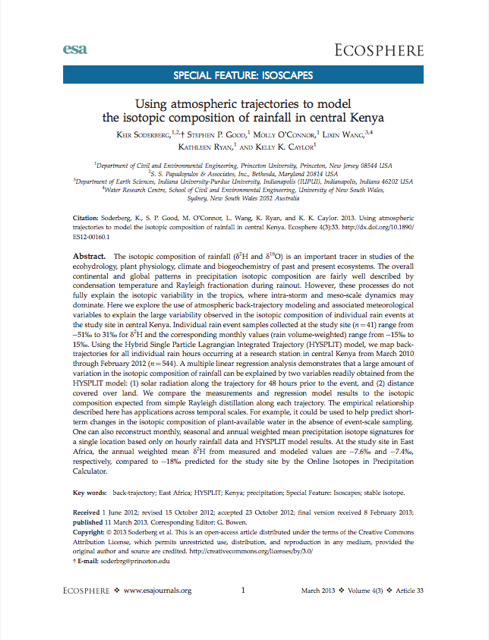Using atmospheric trajectories to model the isotopic composition of rainfall in central Kenya

*Soderberg, Keir, *Stephen P. Good, *Molly O’Connor, *Lixin Wang, *Kathleen Ryan, and Kelly K. Caylor. 2013. Using atmospheric trajectories to model the isotopic composition of rainfall in central Kenya. Ecosphere 4:art33. doi:10.1890/ES12-00160.1
The isotopic composition of rainfall (δ2H and δ18O) is an important tracer in studies of the ecohydrology, plant physiology, climate and biogeochemistry of past and present ecosystems. The overall continental and global patterns in precipitation isotopic composition are fairly well described by condensation temperature and Rayleigh fractionation during rainout. However, these processes do not fully explain the isotopic variability in the tropics, where intra-storm and meso-scale dynamics may dominate. Here we explore the use of atmospheric back-trajectory modeling and associated meteorological variables to explain the large variability observed in the isotopic composition of individual rain events at the study site in central Kenya. Individual rain event samples collected at the study site (n = 41) range from −51‰ to 31‰ for δ2H and the corresponding monthly values (rain volume-weighted) range from −15‰ to 15‰. Using the Hybrid Single Particle Lagrangian Integrated Trajectory (HYSPLIT) model, we map back-trajectories for all individual rain hours occurring at a research station in central Kenya from March 2010 through February 2012 (n = 544). A multiple linear regression analysis demonstrates that a large amount of variation in the isotopic composition of rainfall can be explained by two variables readily obtained from the HYSPLIT model: (1) solar radiation along the trajectory for 48 hours prior to the event, and (2) distance covered over land. We compare the measurements and regression model results to the isotopic composition expected from simple Rayleigh distillation along each trajectory. The empirical relationship described here has applications across temporal scales. For example, it could be used to help predict short-term changes in the isotopic composition of plant-available water in the absence of event-scale sampling. One can also reconstruct monthly, seasonal and annual weighted mean precipitation isotope signatures for a single location based only on hourly rainfall data and HYSPLIT model results. At the study site in East Africa, the annual weighted mean δ2H from measured and modeled values are −7.6‰ and −7.4‰, respectively, compared to −18‰ predicted for the study site by the Online Isotopes in Precipitation Calculator.
